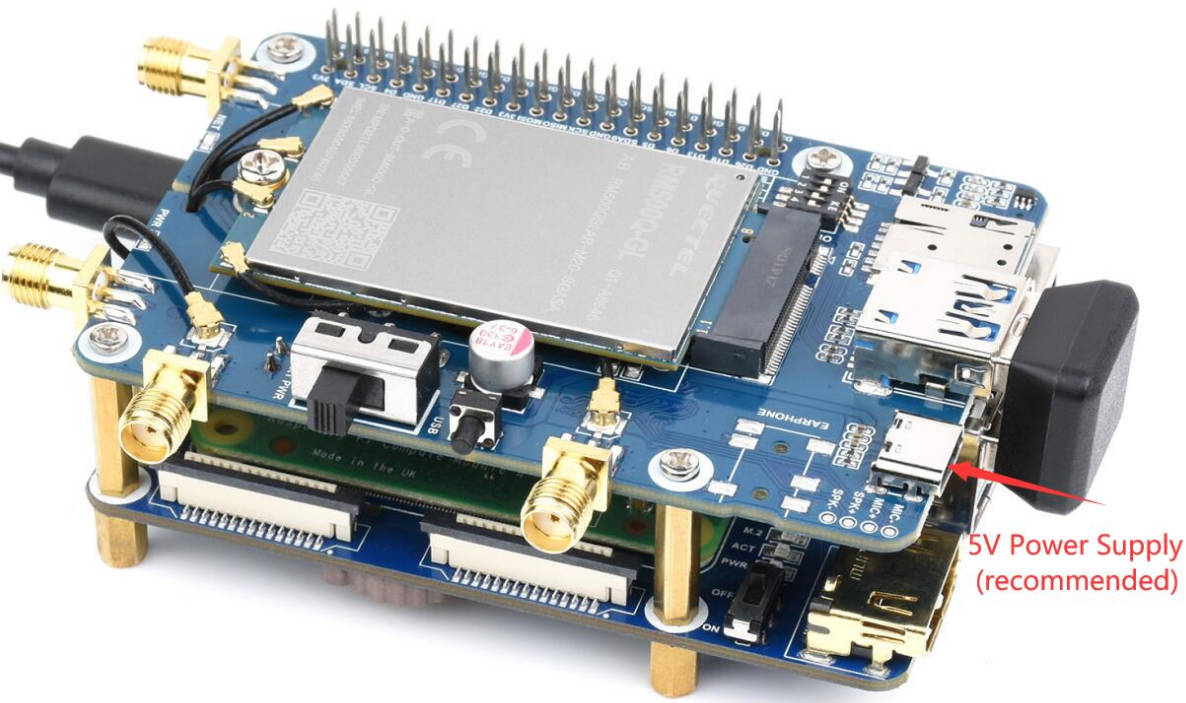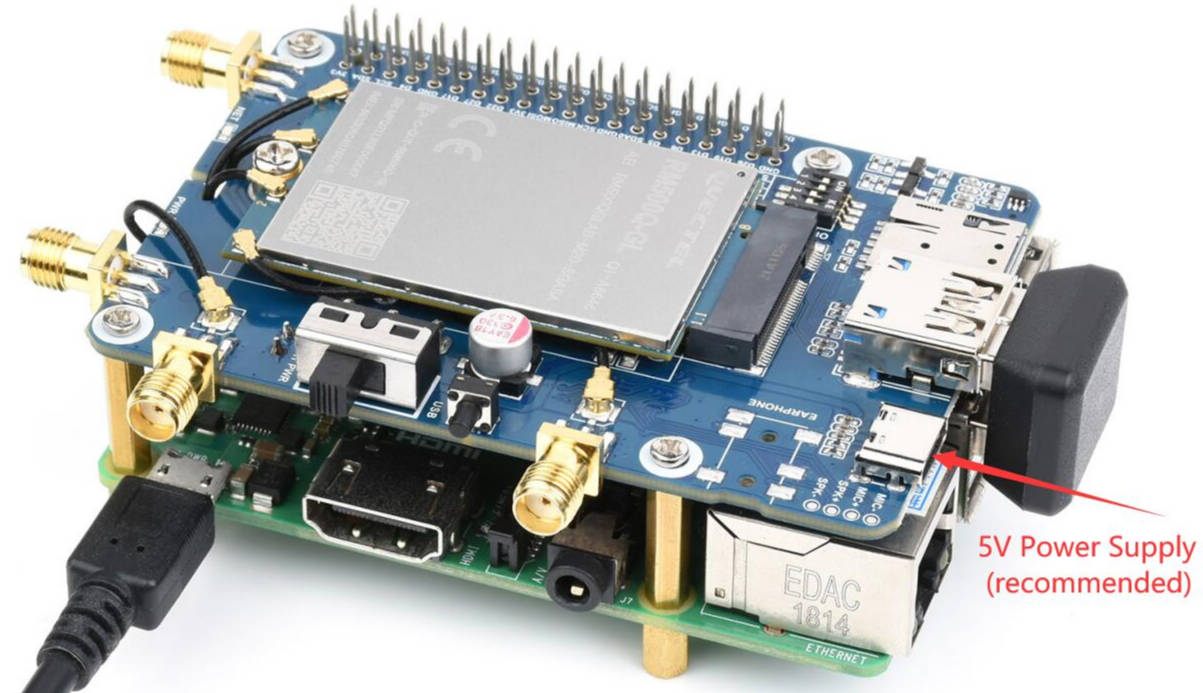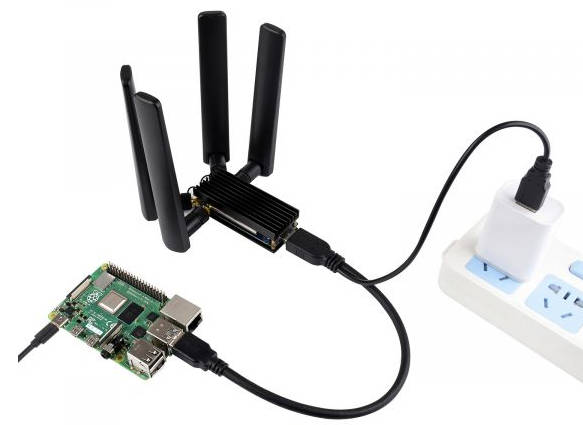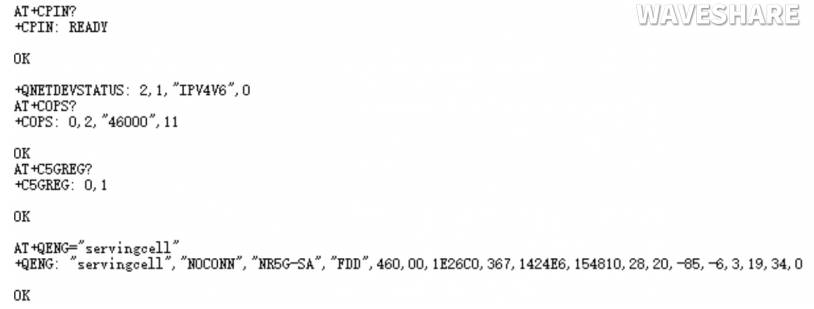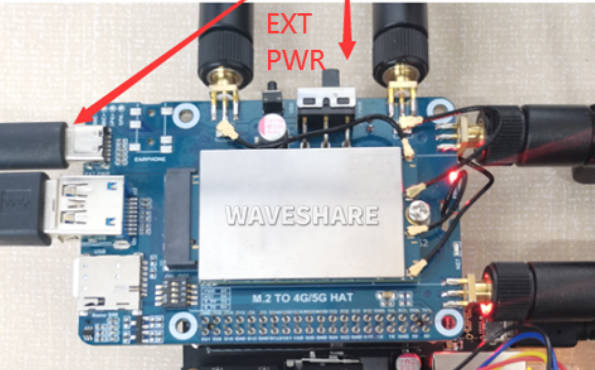- sales/support
Google Chat: zj734465502@gmail.com
- sales
+86-0755-88291180
- sales01
sales@spotpear.com
- sales02
dragon_manager@163.com
- support
tech-support@spotpear.com
- CEO-Complaints
zhoujie@spotpear.com
- sales/support
WhatsApp:13246739196
- HOME
- >
- ARTICLES
- >
- Common Moudle
- >
- GSM-GPS
RM520N GL User Guide
Overview
RM520N-GL is a 5G sub-6GHz module designed for IoT/EMBB applications. Adopts the 3GPP Release16 technology and supports 5G non-standalone (NSA) and standalone (SA) modes. Designed in an M.2 form factor, RM520N-GL is compatible with Quectel RM50xQ 5G module, LTE-A Cat 6 module EM06, Cat 12 modules EM12/EM12xR/EM121R-GL, and Cat 16 module EM160R-GL, which facilitate the migration from LTE-A to 5G. This industrial-grade module is for industrial and commercial applications.
The RM520N-GL series nearly covers all the mainstream carriers worldwide. Integrated GNSS receiver (supports GPS, GLONASS, BDS, and Galileo) greatly simplifies the product design and makes positioning capabilities quicker and more accurate.
Integrates built-in network protocol, and multiple industry-standard interfaces and supports multiple drivers and software functions (such as Windows7, 8, 8.1, 10, USB/PCIe drivers under Linux, Android. etc), which greatly expands its application in IoT and eMBB fields including Industrial Routers, Home Gateways, Set Top Box, industrial laptops, consumer laptops, Industrial PDAs, Rugged Industrial Tablet PCs, Cameras and Surveillance and Digital Signage.
Features
- Designed for IoT/eMBB applications, support 5G/4G/3G, M.2 form factor.
- Full coverage of multi-network standards including 5G and LTE-A.
- Supports NSA and SA modes.
- Multi-constellation GNSS receiver available for applications requiring fast and accurate positioning in any environment.
- Supports multi functions: DFOTA and VoLTE (optional).
- Supports 3GPP Release16.
Selection Guide
| 5G Sub-6 | RM500U-CNV | RM500Q-GL 5G HAT | RM502Q-AE 5G HAT | RM520N-GL | RM530N-GL | |
|---|---|---|---|---|---|---|
| 5G Standard | 3GPP R15 | 3GPP R16 | ||||
| 5G Chip | UNISOC | Qualcomm | ||||
| 5G | Sub-6 GHz | Sub-6 GHz & mmWave | ||||
| Region/Operator | China, EMEA, Asia-Pacific | except Americas | except China | Global | ||
| Operating Temperature | -30°C ~ +75°C | |||||
| Extension Temperature | -40°C ~ +85°C | |||||
| Module Size | 30.0 × 52.0 × 2.3 (mm) | |||||
| Module Weight | 8.8g | 8.7g | 8.8g | |||
| Power Supply | 3.3~4.4V, Typ. 3.7V | 3.135~4.4V, Typ. 3.7V | ||||
| Power Consumption | 78μA @ shutdown; 5.1mA @ hibernate; | 70μA @ shutdown; 4.0mA @ hibernate; | 80μA @ shutdown; 4.2mA @ hibernate; | 195μA @ shutdown; 4.7mA @ hibernate; | 173μA @ shutdown; 5.1mA @ hibernate; | |
| Frequency Band | ||||||
| 5G | 5G NR | - | n257, n258, n260, n261 | |||
| 5G NR NSA | n41, n78, n79 | n41, n77, n78, n79 | n1, n2, n3, n5, n7, n8, n12, n20, n25, n28, n38, n40, n41, n48, n66, n71, n77, n78, n79 | n1, n2, n3, n5, n7, n8, n12, n13, n14, n18, n20, n25, n26, n28, n29, n30, n38, n40, n41, n48, n66, n70, n71, n75, n76, n77, n78, n79 | ||
| 5G NR SA | n1, n2, n3, n5, n8, n28, n41, n77, n78, n79 | n1, n2, n3, n5, n7, n8, n12, n20, n25, n28, n38, n40, n41, n48, n66, n71, n77, n78, n79 | n1, n2, n3, n5, n7, n8, n12, n13, n14, n18, n20, n25, n26, n28, n29, n30, n38, n40, n41, n48, n66, n70, n71, n75, n76, n77, n78, n79 | |||
| LTE | LTE-FDD | B1, B3, B5, B8 | B1, B2, B3, B4, B5, B7, B8, B12, B13, B14, B17, B18, B19, B20, B25, B26, B28, B29, B30, B32, B66, B71 | |||
| LTE-TDD | B34, B38, B39, B40, B41 | B34, B38, B39, B40, B41, B42, B43, B48 | ||||
| LAA | - | B46 | ||||
| UMTS | WCDMA | B1, B5, B8 | B1, B2, B3, B4, B5, B6, B8, B19 | B1, B2, B4, B5, B8, B19 | ||
| GNSS | - | GPS / GLONASS / BeiDou(Compass) / Galileo / QZSS (only RM520N-GL and RM530N-GL support) | ||||
| Data Rate | ||||||
| 5G mmWave | - | DL 4.0Gbps; UL 1.4Gbps | ||||
| 5G SA Sub-6 | DL 2Gbps; UL 1Gbps | DL 2.1Gbps; UL 900Mbps | DL 4.2Gbps; UL 450Mbps | DL 2.4Gbps; UL 900Mbps | ||
| 5G NSA Sub-6 | DL 2.2Gbps; UL 575Mbps | DL 2.5Gbps; UL 600/650Mbps | DL 5Gbps; UL 650Mbps | DL 3.4Gbps; UL 550Mbps | ||
| LTE | DL 600Mbps; UL 150Mbps | DL 1.0Gbps; UL 200Mbps | DL 2Gbps; UL 200Mbps | DL 1.6Gbps; UL 200Mbps | ||
| UMTS | DL 42.2Mbps; UL 11Mbps | DL 42Mbps; UL 5.76Mbps | ||||
Recommended Carrier Board
RM520N-GL adopts the standard M.2 Key B slot, which is compatible with the Waveshare's 4G/5G module with M.2 slot. The two commonly used carrier board for 4G/5G M.2 tests is listed below:
| Model | USB TO M.2 B KEY | M.2 TO 4G/5G HAT |
|---|---|---|
| Module Interface | M.2 port | M.2 port |
| Communication Interface | USB 3.0 | USB 3.0 |
| Application | 5G Dongle with access to Windows/Linux computers | 4G/5G Module designed for Raspberry Pi |
| OS | Windows/Linux | Raspberry OS/OpenWRT and other common Linux systems for Raspberry Pi |
USB TO M.2 B KEY
1. Hardware Connection
【Hardware Preparation】
- RM520N-GL × 1
- USB TO M.2 B KEY × 1
- 5G SIM card × 1
【Installation Guide】
Please refer to the following diagram to install the Nano SIM card (5G function should be enabled) and 5G module, and then install the heat sink, cooling silicone, and 5G antenna, see the following figure:
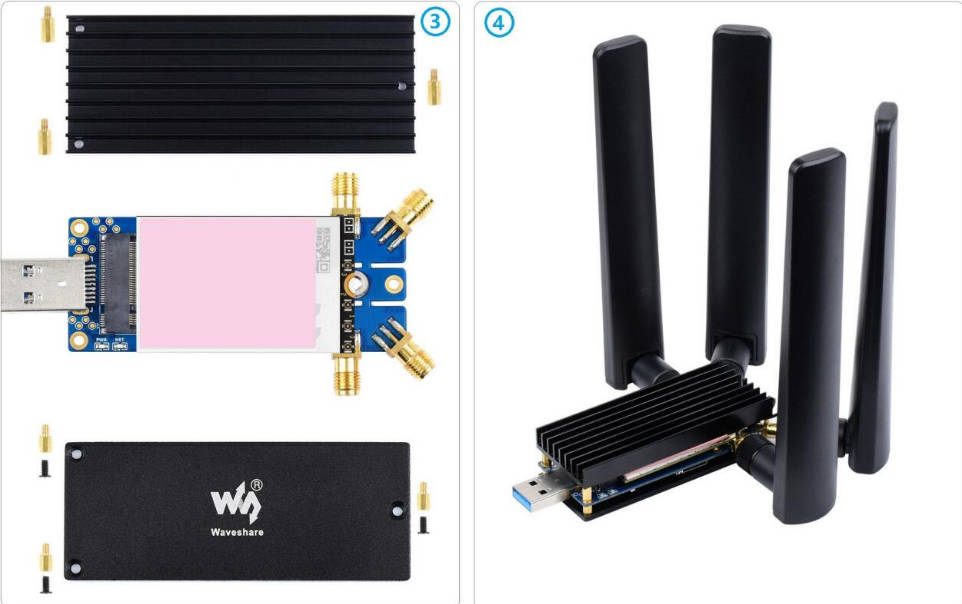
Using the USB TO M.2 B KEY board, the RM520N-GL 5G module can be plugged into a Linux host board such as a Windows computer/laptop, Raspberry Pi, or Jetson Nano via the USB 3.0 interface.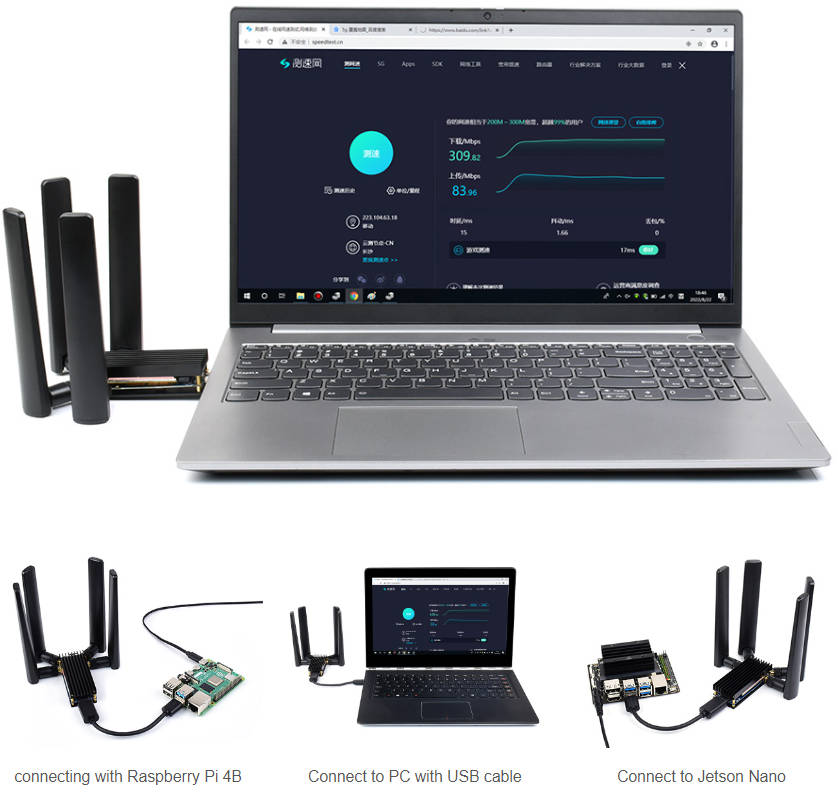
2. Connecting with Windows
2.1 Driver Installation in Windows
- Refer to the hardware connection above and connect the module to the Windows PC via USB TO M.2 B KEY.
- Install Windows-related drivers:
- RM520N-GL Windows NDIS Driver
- RM520N-GL Windows MBIM Driver
- Comparison of device manager recognition before and after driver installation (the following figure is a screenshot of the actual test under the Windows 10 system).
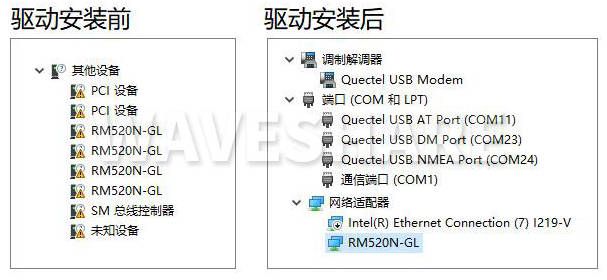
2.2 5G Network Speed Test
- Under the Windows system, it is recommended to use MBIM mode for 5G networking.
In general, after installing the driver according to the section 2.1 Windows Driver Installation, the computer device manager and network connection can be identified normally.
RM520N-GL network card, as shown in the following figure: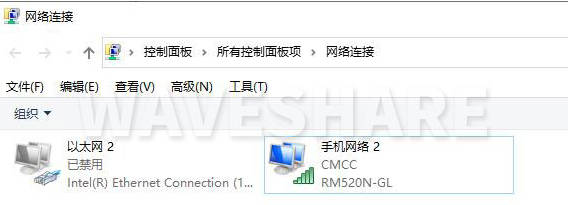
At this point, as long as the SIM card and band of the RM520N-GL 5G module that is connected to the RM520N-GL 5G module are available in the test area, the 5G network can be obtained automatically, as shown in the following figure:
- If the driver is installed and the
Quectel USB AT Port (COM)is identified, but the RM520N-GL NIC device is not identified, it is possible that the factory default of the 5G module is not MBIM mode or you have modified it to other modes in use. At this time, you can try to use SSCOM or QCOM serial assistant, openQuectel USB AT Port (COM)to send AT command to set to MBIM mode, the command is as follows:
AT+QCFG="usbnet",2 AT+CFUN=1,1
- After confirming that the module can normally access the Internet through 5G, we can use network speed test tools to test the speed of 5G Internet access, the following figure is a screenshot of the actual test with speed test software:
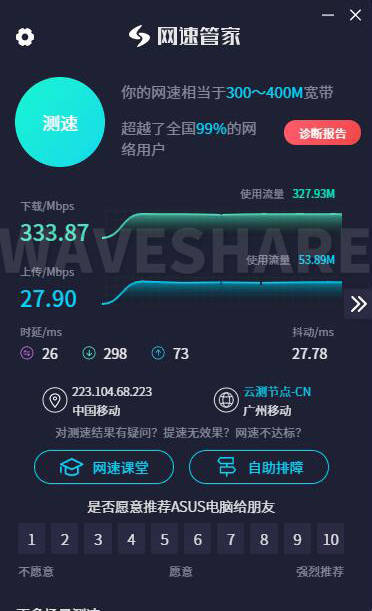
2.3 GNSS Positioning Test
- Connect the passive GPS antenna to ANT3 of the module (corresponding to L1 of GNSS), note that the lettered side is facing down and the antenna is placed in an open outdoor test (note that GNSS positioning test cannot be performed in rainy weather).
- Then SSCOM or QCOM serial assistant opens
Quectel USB AT Port (COM)to send AT commands:
AT+QGPS=1 //Open GPS positioning AT+QGPSLOC=0 //Get GPS position
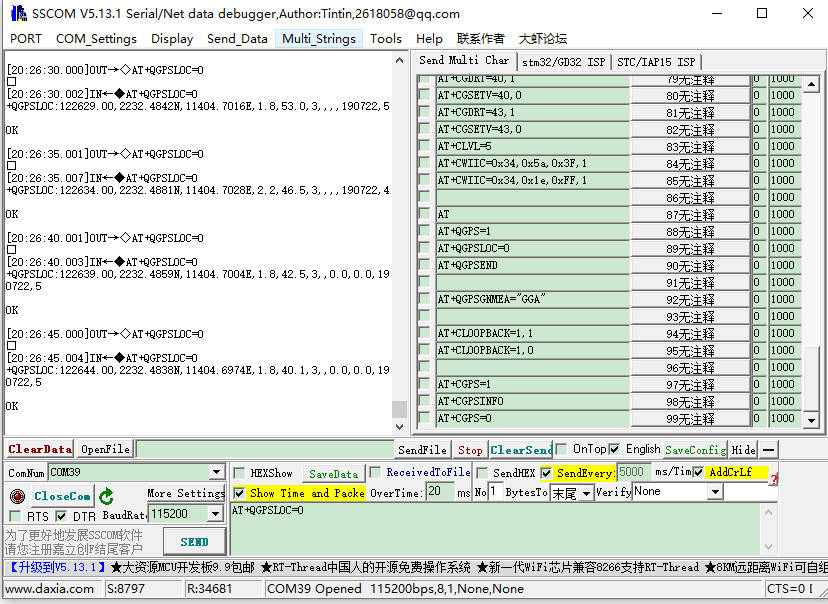
- With GNSS positioning enabled, you can open the
Quectel USB NMEA Port (COM)through SSCOM, QCOM serial assistant, or other positioning software to see the NMEA GPS positioning data output from this port, as shown below:
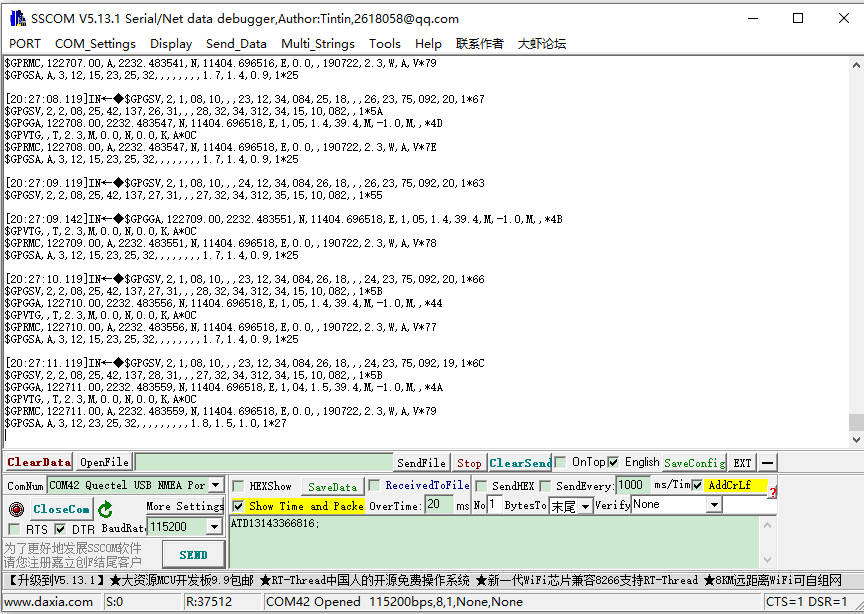
- GNSS positioning test completed, AT command can be sent to
Quectel USB AT Port (COM)to turn off GNSS positioning:
AT+QGPS=0 //disable GNSS positioning
3. Connect to other Linux main control such as Raspberry Pi/Jetson Nano
- Note: Linux system usage, same as M.2 TO 4G/5G HAT Raspberry Pi Linux Usage section.
M.2 TO 4G/5G HAT
【Hardware Preparation】
- 5G SIM Card x 1
- RM520N-GL 5G HAT (with case) x 1 (kits included as shown below):
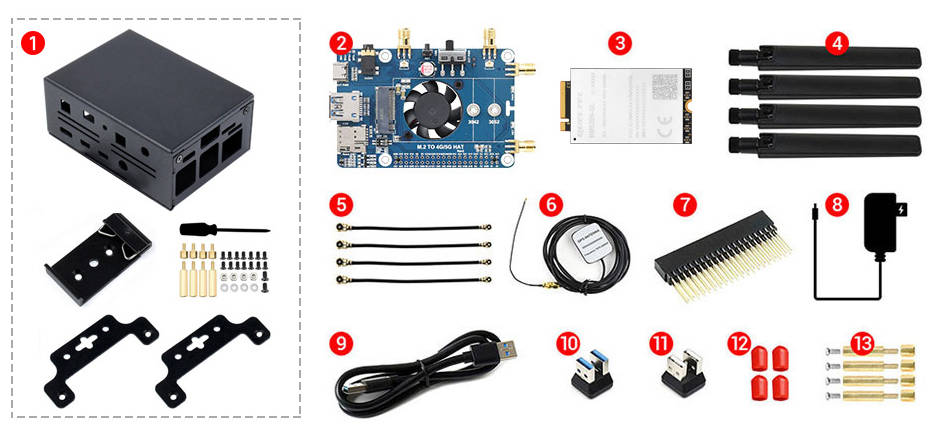
【Installation Guide】
- Use the double-plug USB 3.0 cable to connect the 5G HAT, and then connect the external 5V power to the Type-C power port of the 5G HAT. As shown below:
| Raspberry Pi Board | Pi 4B | Pi 3B/3B+ | CM4-IO-BASE |
|---|---|---|---|
| USB adapter | USB3.0 adapter | USB2.0 adapter | USB3.0 adapter |
| Connection Diagram |
- If it is used for PI4B, there is a matching case with the following installation schematic:

【Raspberry Pi 5G Networking Guide】
Working with Raspberry Pi O
- It is recommended to use it in the newest Raspberry Pi OS with driver-free support.




